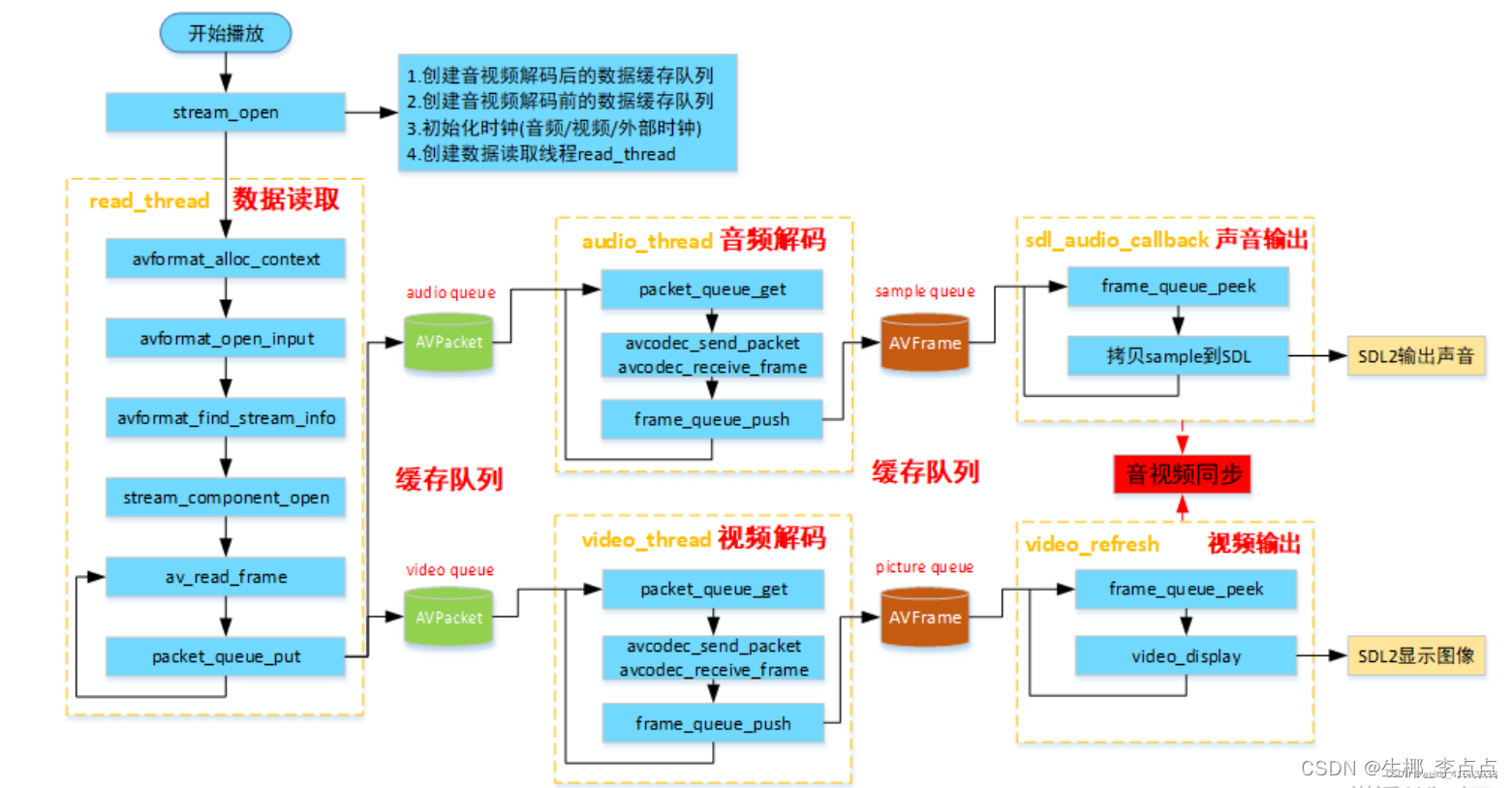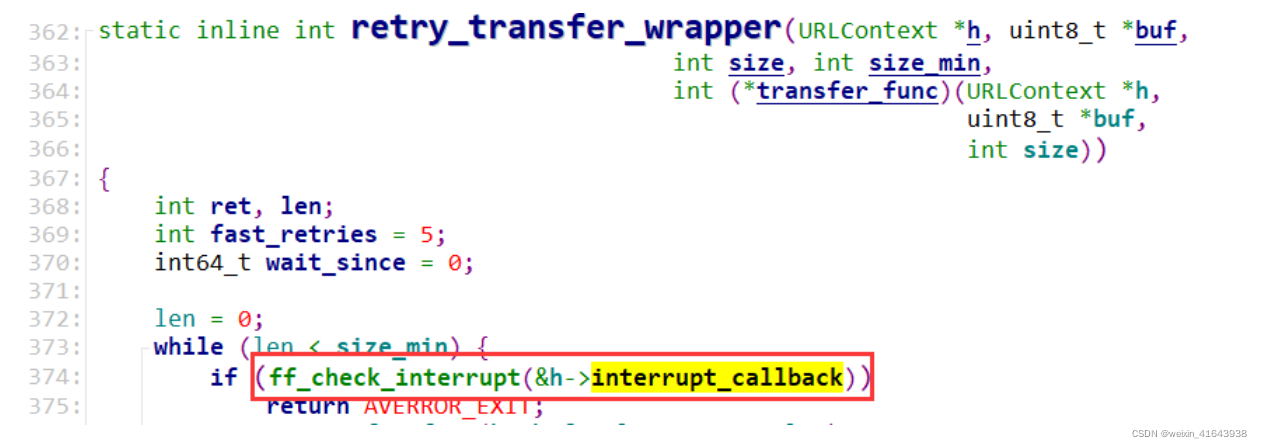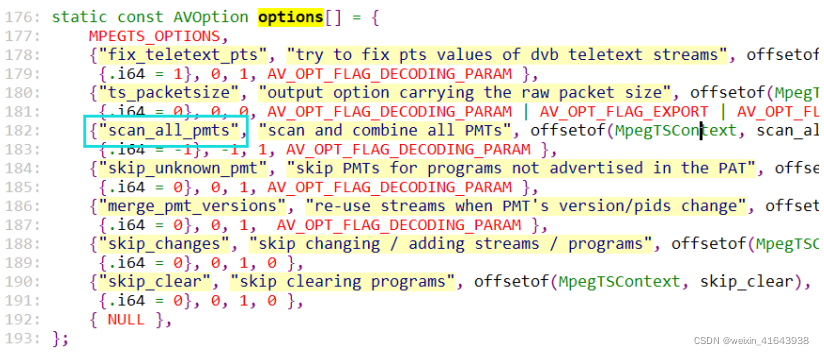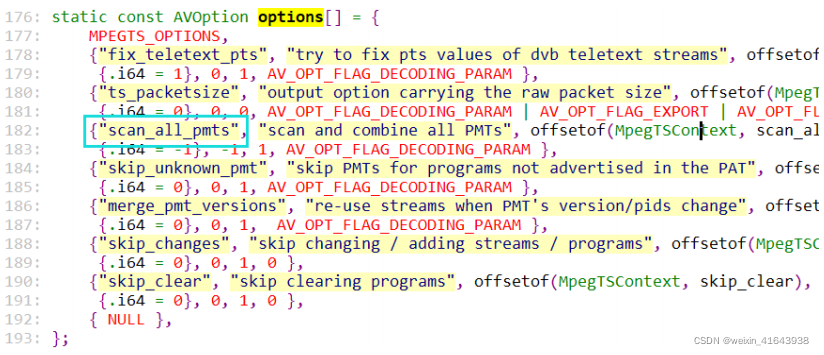
数据读取线程
从ffplay框架分析我们可以看到,ffplay有专⻔的线程read_thread()读取数据,且在调⽤av_read_frame 读取数据包之前需要做例如打开⽂件,查找配置解码器,初始化⾳视频输出等准备阶段,主要包括三⼤步骤:
- 准备⼯作
- For循环读取数据
- 退出线程处理
⼀ 准备⼯作
- avformat_alloc_context 创建上下⽂
- ic->interrupt_callback.callback = decode_interrupt_cb;
- avformat_open_input打开媒体⽂件
- avformat_find_stream_info 读取媒体⽂件的包获取更多的stream信息
- 检测是否指定播放起始时间,如果指定时间则seek到指定位置avformat_seek_file
- 查找查找AVStream,讲对应的index值记录到st_index[AVMEDIA_TYPE_NB];
- a. 根据⽤户指定来查找avformat_match_stream_specifier
- b. 使⽤av_find_best_stream查找流
- 从待处理流中获取相关参数,设置显示窗⼝的宽度、⾼度及宽⾼⽐
- stream_component_open打开⾳频、视频、字幕解码器,并创建相应的解码线程以及进⾏对应输出参 数的初始化。
⼆ For循环读取数据
- 检测是否退出
- 检测是否暂停/继续
- 检测是否需要seek
- 检测video是否为attached_pic
- 检测队列是否已经有⾜够数据
- 检测码流是否已经播放结束
- a. 是否循环播放
- b. 是否⾃动退出
- 使⽤av_read_frame读取数据包
- 检测数据是否读取完毕
- 检测是否在播放范围内
- 到这步才将数据插⼊对应的队列
三 退出线程处理
- 如果解复⽤器有打开则关闭avformat_close_input
- 调⽤SDL_PushEvent发送退出事件FF_QUIT_EVENT
- 消耗互斥量wait_mutex
准备⼯作
准备⼯作主要包括以下步骤:
- avformat_alloc_context 创建上下⽂
- ic->interrupt_callback.callback = decode_interrupt_cb;
- avformat_open_input打开媒体⽂件
- avformat_find_stream_info 读取媒体⽂件的包获取更多的stream信息
- 检测是否指定播放起始时间,如果指定时间则seek到指定位置avformat_seek_file
- 查找查找AVStream,讲对应的index值记录到st_index[AVMEDIA_TYPE_NB];
- a. 根据⽤户指定来查找流avformat_match_stream_specifier
- b. 使⽤av_find_best_stream查找流
- 通过AVCodecParameters和av_guess_sample_aspect_ratio计算出显示窗⼝的宽、⾼
- stream_component_open打开⾳频、视频、字幕解码器,并创建相应的解码线程以及进⾏对应输出参 数的初始化。
avformat_alloc_context 创建上下⽂
调⽤avformat_alloc_context创建解复⽤器上下⽂
// 1. 创建上下⽂结构体,这个结构体是最上层的结构体,表示输⼊上下⽂
ic = avformat_alloc_context();
is->ic = ic; // videoState的ic指向分配的ic
ic->interrupt_callback
/* 2.设置中断回调函数,如果出错或者退出,就根据⽬前程序设置的状态选择继续check或者直 接退出 */
/* 当执⾏耗时操作时(⼀般是在执⾏while或者for循环的数据读取时),会调⽤interrupt_ callback.callback
* 回调函数中返回1则代表ffmpeg结束耗时操作退出当前函数的调⽤
* * 回调函数中返回0则代表ffmpeg内部继续执⾏耗时操作,直到完成既定的任务(⽐如读取到既定 的数据包)
* */
ic->interrupt_callback.callback = decode_interrupt_cb;
ic->interrupt_callback.opaque = is;
interrupt_callback⽤于ffmpeg内部在执⾏耗时操作时检查调⽤者是否有退出请求,避免⽤户退出请求没 有及时响应。
怎么去测试在哪⾥触发?
在ubuntu使⽤gdb进⾏调试:然后在decode_interrupt_cb打断点。
avformat_open_input的触发
#0 decode_interrupt_cb (ctx=0x7ffff7e36040) at fftools/ffplay.c:271 5
#1 0x00000000007d99b7 in ff_check_interrupt (cb=0x7fffd00014b0) at libavformat/avio.c:667
#2 retry_transfer_wrapper (transfer_func=0x7dd950 <file_read>, size _min=1, size=32768, buf=0x7fffd0001700 "", h=0x7fffd0001480) at libavformat/avio.c:374
#3 ffurl_read (h=0x7fffd0001480, buf=0x7fffd0001700 "", size=32768) at libavformat/avio.c:411
#4 0x000000000068cd9c in read_packet_wrapper (size=<optimized out>, buf=<optimized out>, s=0x7fffd00011c0) at libavformat/aviobuf.c: 535
#5 fill_buffer (s=0x7fffd00011c0) at libavformat/aviobuf.c:584
#6 avio_read (s=s@entry=0x7fffd00011c0, buf=0x7fffd0009710 "", size=size@entry=2048) at libavformat/aviobuf.c:677
#7 0x00000000006b7780 in av_probe_input_buffer2 (pb=0x7fffd00011c0, fmt=0x7fffd0000948, filename=filename@entry=0x31d50e0 "source.200kbps.768x320.flv", logctx=logctx@entry=0x7fffd0000940, offset=offset@entry=0, max_probe_size=1048576) at libavformat/format.c:262
#8 0x00000000007b631d in init_input (options=0x7fffdd9bcb50, filename=0x31d50e0 "source.200kbps.768x320.flv", s=0x7fffd000094 0) at libavformat/utils.c:443
#9 avformat_open_input (ps=ps@entry=0x7fffdd9bcbf8, filename=0x31d50e0 "source.200kbps.768x320.flv", fmt=<optimized out>,
可以看到是在libavformat/avio.c:374⾏有触发到

avformat_find_stream_info的触发
#0 decode_interrupt_cb (ctx=0x7ffff7e36040) at fftools/ffplay.c:2715
#1 0x00000000007b25bc in avformat_find_stream_info (ic=0x7fffd000094 0, options=0x0) at libavformat/utils.c:3693
#2 0x00000000004a6ea9 in read_thread (arg=0x7ffff7e36040)
从该调⽤栈可以看出来 avformat_find_stream_info也会触发ic->interrupt_callback的调⽤,具体可以 看代码(libavformat/utils.c:3693⾏)

av_read_frame的触发
#0 decode_interrupt_cb (ctx=0x7ffff7e36040) at fftools/ffplay.c:271 5
#1 0x00000000007d99b7 in ff_check_interrupt (cb=0x7fffd00014b0) at libavformat/avio.c:667
#2 retry_transfer_wrapper (transfer_func=0x7dd950 <file_read>, size _min=1, size=32768, buf=0x7fffd0009710 "FLV\001\005", h=0x7fffd0001480) at libavformat/avio.c:374
#3 ffurl_read (h=0x7fffd0001480, buf=0x7fffd0009710 "FLV\001\005", size=32768) at libavformat/avio.c:411
#4 0x000000000068cd9c in read_packet_wrapper (size=<optimized out>, buf=<optimized out>, s=0x7fffd00011c0) at libavformat/aviobuf.c: 535
#5 fill_buffer (s=0x7fffd00011c0) at libavformat/aviobuf.c:584
#6 avio_read (s=s@entry=0x7fffd00011c0, buf=0x7fffd00dbf6d "\177", size=45, size@entry=90) at libavformat/aviobuf.c:677
#7 0x00000000007a99d5 in append_packet_chunked (s=0x7fffd00011c0, pkt=pkt@entry=0x7fffdd9bca00, size=size@entry=90) at libavformat/utils.c:293
#8 0x00000000007aa969 in av_get_packet (s=<optimized out>, pkt=pkt@entry=0x7fffdd9bca00, size=size@entry=90) at libavformat/utils.c:317
#9 0x00000000006b350a in flv_read_packet (s=0x7fffd0000940, pkt=0x7fffdd9bca00) at libavformat/flvdec.c:1295
#10 0x00000000007aad6d in ff_read_packet (s=s@entry=0x7fffd0000940,pkt=pkt@entry=0x7fffdd9bca00) at libavformat/utils.c:856 ---Type <return> to continue, or q <return> to quit---
#11 0x00000000007ae291 in read_frame_internal (s=0x7fffd0000940, pkt=0x7fffdd9bcc00) at libavformat/utils.c:1582
#12 0x00000000007af422 in av_read_frame (s=0x7fffd0000940, pkt=pkt@entry=0x7fffdd9bcc00) at libavformat/utils.c:1779
#13 0x00000000004a68b1 in read_thread (arg=0x7ffff7e36040) at fftools/ffplay.c:3008
这⾥的触发和avformat_open_input⼀致,⼤家可以⾃⾏跟踪调⽤栈。
avformat_open_input()打开媒体文件
函数原型:
/** * Open an input stream and read the header. The codecs are not opened.
* The stream must be closed with avformat_close_input().
*
* @param ps Pointer to user-supplied AVFormatContext (allocated by avformat_alloc_context).
* May be a pointer to NULL, in which case an AVFormatContext is allocated by this
* function and written into ps.
* Note that a user-supplied AVFormatContext will be freed on failure.
* @param url URL of the stream to open.
* @param fmt If non-NULL, this parameter forces a specific input format.
* Otherwise the format is autodetected.
* @param options A dictionary filled with AVFormatContext and demuxer-private options.
* On return this parameter will be destroyed and replaced with a dict containing
* options that were not found. May be NULL.
*
* @return 0 on success, a negative AVERROR on failure.
*
* @note If you want to use custom IO, preallocate the format context and set its pb field. */
int avformat_open_input(AVFormatContext **ps, const char *url, ff_const59 AVInputFormat *fmt, AVDictionary **options);
avformat_open_input⽤于打开输⼊⽂件(对于RTMP/RTSP/HTTP⽹络流也是⼀样,在ffmpeg内部都 抽象为URLProtocol,这⾥描述为⽂件是为了⽅便与后续提到的AVStream的流作区分),读取视频⽂件 的基本信息。
需要提到的两个参数是fmt和options。通过fmt可以强制指定视频⽂件的封装,options可以传递额外参数 给封装(AVInputFormat)。
主要代码:
if (!av_dict_get(format_opts, "scan_all_pmts", NULL, AV_DICT_MATCH_CASE)) {
av_dict_set(&format_opts, "scan_all_pmts", "1", AV_DICT_DONT_OVERWRITE);
scan_all_pmts_set = 1;
}
/* 3.打开文件,主要是探测协议类型,如果是网络文件则创建网络链接等 */
err = avformat_open_input(&ic, is->filename, is->iformat, &format_opts);
if (err < 0) {
print_error(is->filename, err);
ret = -1;
goto fail;
}
if (scan_all_pmts_set)
av_dict_set(&format_opts, "scan_all_pmts", NULL, AV_DICT_MATCH_CASE);
if ((t = av_dict_get(format_opts, "", NULL, AV_DICT_IGNORE_SUFFIX))) {
av_log(NULL, AV_LOG_ERROR, "Option %s not found.\n", t->key);
ret = AVERROR_OPTION_NOT_FOUND;
goto fail;
}
scan_all_pmts是mpegts的⼀个选项,表示扫描全部的ts流的"Program Map Table"表。这⾥在没有设定 该选项的时候,强制设为1。最后执⾏avformat_open_input。
使⽤gdb跟踪options的设置,在av_opt_set打断点
(gdb) b av_opt_set
(gdb) r
#0 av_opt_set_dict2 (obj=obj@entry=0x7fffd0000940, options=options@entry=0x7fffdd9bcb50, search_flags=search_flags@entry=0) at libavutil/opt.c:1588
#1 0x00000000011c6837 in av_opt_set_dict (obj=obj@entry=0x7fffd0000940, options=options@entry=0x7fffdd9bcb50) at libavutil/opt.c:1605
#2 0x00000000007b5f8b in avformat_open_input (ps=ps@entry=0x7fffdd9bcbf8, filename=0x31d23d0 "source.200kbps.768x320.flv", fmt=<optimized out>, options=0x2e2d450 <format_opts>) at libavformat/utils.c:560
#3 0x00000000004a70ae in read_thread (arg=0x7ffff7e36040) at fftools/ffplay.c:2780
......
(gdb) l
1583
1584 if (!options)
1585 return 0;
1586
1587 while ((t = av_dict_get(*options, "", t, AV_DICT_IGNORE_SUFFIX))) {
1588 ret = av_opt_set(obj, t->key, t->value, search_flags);
1589 if (ret == AVERROR_OPTION_NOT_FOUND)
1590 ret = av_dict_set(&tmp, t->key, t->value, 0);
1591 if (ret < 0) {
1592 av_log(obj, AV_LOG_ERROR, "Error setting option %s to value %s.\n", t->key, t->value);
(gdb) print **options $3 = {count = 1, elems = 0x7fffd0001200}
(gdb) print (*options)->elems $4 = (AVDictionaryEntry *) 0x7fffd0001200
(gdb) print *((*options)->elems) $5 = {key = 0x7fffd0001130 "scan_all_pmts", value = 0x7fffd0001150 "1"}
(gdb)
参数的设置最终都是设置到对应的解复⽤器,⽐如:
mpegts.c

flvdec.c

avformat_find_stream_info()
在打开了⽂件后,就可以从AVFormatContext中读取流信息了。⼀般调⽤avformat_find_stream_info获 取完整的流信息。为什么在调⽤了avformat_open_input后,仍然需要调⽤avformat_find_stream_info 才能获取正确的流信息呢?看下注释:
/**
* Read packets of a media file to get stream information. This
* is useful for file formats with no headers such as MPEG. This
* function also computes the real framerate in case of MPEG-2 repeat
* frame mode.
* The logical file position is not changed by this function;
* examined packets may be buffered for later processing.
*
* @param ic media file handle
* @param options If non-NULL, an ic.nb_streams long array of pointers to
* dictionaries, where i-th member contains options for * codec corresponding to i-th stream.
* On return each dictionary will be filled with options that were not found.
* @return >=0 if OK, AVERROR_xxx on error
*
* @note this function isn't guaranteed to open all the codecs, so
* options being non-empty at return is a perfectly normal behavior.
*
* @todo Let the user decide somehow what information is needed so that
* we do not waste time getting stuff the user does not need. */
int avformat_find_stream_info(AVFormatContext *ic, AVDictionary **options);
该函数是通过读取媒体⽂件的部分数据来分析流信息。在⼀些缺少头信息的封装下特别有⽤,⽐如说 MPEG(⾥应该说ts更准确)(FLV⽂件也是需要读取packet 分析流信息)。⽽被读取⽤以分析流信息的数 据可能被缓存,供av_read_frame时使⽤,在播放时并不会跳过这部分packet的读取。
检测是否指定播放起始时间
如果指定时间则seek到指定位置avformat_seek_file。 可以通过 ffplay -ss 设置起始时间,时间格式hh:mm:ss,⽐如 ffplay -ss 00:00:30 test.flv 则是从30秒的起始位置开始播放。
具体调⽤流程,可以在opt_seek 函数打断点进⾏测试
{ "ss", HAS_ARG, { .func_arg = opt_seek }, "seek to a given position in seconds", "pos" },
{ "t", HAS_ARG, { .func_arg = opt_duration }, "play \"duration\" sec onds of audio/video", "duration" },
/* if seeking requested, we execute it */
/* 5. 检测是否指定播放起始时间 */
if (start_time != AV_NOPTS_VALUE) {
int64_t timestamp;
timestamp = start_time;
/* add the stream start time */
if (ic->start_time != AV_NOPTS_VALUE)
timestamp += ic->start_time;
// seek的指定的位置开始播放
ret = avformat_seek_file(ic, -1, INT64_MIN, timestamp, INT64_MAX , 0);
if (ret < 0) {
av_log(NULL, AV_LOG_WARNING, "%s: could not seek to position %0.3f\n",
is->filename, (double)timestamp / AV_TIME_BASE);
}
}
查找AVStream
⼀个媒体⽂件,对应有0n个⾳频流、0n个视频流、0~n个字幕流,⽐如这⾥我们⽤了2_audio.mp4是有 2个⾳频流,1个视频流

具体现在那个流进⾏播放我们有两种策略:
- 在播放起始指定对应的流
- 使⽤缺省的流进⾏播放
1 在播放起始指定对应的流
ffplay是通过通过命令可以指定流
{ "ast", OPT_STRING | HAS_ARG | OPT_EXPERT, { &wanted_stream_spec[AVMEDIA_TYPE_AUDIO] }, "select desired audio stream", "stream_specifier" },
{ "vst", OPT_STRING | HAS_ARG | OPT_EXPERT, { &wanted_stream_spec[AVMEDIA_TYPE_VIDEO] }, "select desired video stream", "stream_specifier" },
{ "sst", OPT_STRING | HAS_ARG | OPT_EXPERT, { &wanted_stream_spec[AVMEDIA_TYPE_SUBTITLE] }, "select desired subtitle stream", "stream_specifier" },
可以通过
- -ast n 指定⾳频流(⽐如我们在看电影时,有些电影可以⽀持普通话和英⽂切换,此时可以⽤该命令 进⾏选择)
- -vst n 指定视频流
- -vst n 指定字幕流
讲对应的index值记录到st_index[AVMEDIA_TYPE_NB];
2 使⽤缺省的流进⾏播放
如果我们没有指定,则ffplay主要是通过 av_find_best_stream 来选择,其原型为:
/**
* Find the "best" stream in the file.
* The best stream is determined according to various heuristics as the most
* likely to be what the user expects.
* If the decoder parameter is non-NULL, av_find_best_stream will find the
* default decoder for the stream's codec; streams for which no decoder can
* be found are ignored.
* * @param ic media file handle
* @param type stream type: video, audio, subtitles, etc.
* @param wanted_stream_nb user-requested stream number,
* or -1 for automatic selection
* @param related_stream try to find a stream related (eg. in the same
* program) to this one, or -1 if none
* @param decoder_ret if non-NULL, returns the decoder for the
* selected stream
* @param flags flags; none are currently defined
* @return the non-negative stream number in case of success,
* AVERROR_STREAM_NOT_FOUND if no stream with the requested type
* could be found,
* AVERROR_DECODER_NOT_FOUND if streams were found but no decoder
* @note If av_find_best_stream returns successfully and decoder_ret is not
* NULL, then *decoder_ret is guaranteed to be set to a valid AVCodec.
*/
int av_find_best_stream(AVFormatContext *ic,
enum AVMediaType type,
int wanted_stream_nb,
int related_stream,
AVCodec **decoder_ret,
int flags);
具体代码流程
// 6.1 根据用户指定来查找流,
for (i = 0; i < ic->nb_streams; i++) {
AVStream *st = ic->streams[i];
enum AVMediaType type = st->codecpar->codec_type;
st->discard = AVDISCARD_ALL;
if (type >= 0 && wanted_stream_spec[type] && st_index[type] == -1)
if (avformat_match_stream_specifier(ic, st, wanted_stream_spec[type]) > 0)
st_index[type] = i;
}
for (i = 0; i < AVMEDIA_TYPE_NB; i++) {
if (wanted_stream_spec[i] && st_index[i] == -1) {
av_log(NULL, AV_LOG_ERROR, "Stream specifier %s does not match any %s stream\n",
wanted_stream_spec[i], av_get_media_type_string(i));
// st_index[i] = INT_MAX;
st_index[i] = -1;
}
}
// 6.2 利用av_find_best_stream选择流,
if (!video_disable)
st_index[AVMEDIA_TYPE_VIDEO] =
av_find_best_stream(ic, AVMEDIA_TYPE_VIDEO,
st_index[AVMEDIA_TYPE_VIDEO], -1, NULL, 0);
if (!audio_disable)
st_index[AVMEDIA_TYPE_AUDIO] =
av_find_best_stream(ic, AVMEDIA_TYPE_AUDIO,
st_index[AVMEDIA_TYPE_AUDIO],
st_index[AVMEDIA_TYPE_VIDEO],
NULL, 0);
if (!video_disable && !subtitle_disable)
st_index[AVMEDIA_TYPE_SUBTITLE] =
av_find_best_stream(ic, AVMEDIA_TYPE_SUBTITLE,
st_index[AVMEDIA_TYPE_SUBTITLE],
(st_index[AVMEDIA_TYPE_AUDIO] >= 0 ?
st_index[AVMEDIA_TYPE_AUDIO] :
st_index[AVMEDIA_TYPE_VIDEO]),
NULL, 0);
- 如果⽤户没有指定流,或指定部分流,或指定流不存在,则主要由av_find_best_stream发挥作⽤。
- 如果指定了正确的wanted_stream_nb,⼀般情况都是直接返回该指定流,即⽤户选择的流。
- 如果指定了相关流,且未指定⽬标流的情况,会在相关流的同⼀个节⽬中查找所需类型的流,但⼀般结 果,都是返回该类型第1个流。
通过AVCodecParameters和av_guess_sample_aspect_ratio计算出显示窗⼝的宽、⾼
//7 从待处理流中获取相关参数,设置显示窗口的宽度、高度及宽高比
if (st_index[AVMEDIA_TYPE_VIDEO] >= 0) {
AVStream *st = ic->streams[st_index[AVMEDIA_TYPE_VIDEO]];
AVCodecParameters *codecpar = st->codecpar;
/*根据流和帧宽高比猜测帧的样本宽高比。该值只是一个参考
*/
AVRational sar = av_guess_sample_aspect_ratio(ic, st, NULL);
if (codecpar->width) {
// 设置显示窗口的大小和宽高比
set_default_window_size(codecpar->width, codecpar->height, sar);
}
}
具体流程如上所示,这⾥实质只是设置了default_width、default_height变量的⼤⼩,没有真正改变窗 ⼝的⼤⼩。真正调整窗⼝⼤⼩是在视频显示调⽤video_open()函数进⾏设置
stream_component_open()
经过以上步骤,⽂件打开成功,且获取了流的基本信息,并选择⾳频流、视频流、字幕流。接下来就可以 所选流对应的解码器了。
/* 8. 打开视频、音频解码器。在此会打开相应解码器,并创建相应的解码线程。 */
if (st_index[AVMEDIA_TYPE_AUDIO] >= 0) {// 如果有音频流则打开音频流
stream_component_open(is, st_index[AVMEDIA_TYPE_AUDIO]);
}
ret = -1;
if (st_index[AVMEDIA_TYPE_VIDEO] >= 0) { // 如果有视频流则打开视频流
ret = stream_component_open(is, st_index[AVMEDIA_TYPE_VIDEO]);
}
if (is->show_mode == SHOW_MODE_NONE) {
//选择怎么显示,如果视频打开成功,就显示视频画面,否则,显示音频对应的频谱图
is->show_mode = ret >= 0 ? SHOW_MODE_VIDEO : SHOW_MODE_RDFT;
}
if (st_index[AVMEDIA_TYPE_SUBTITLE] >= 0) { // 如果有字幕流则打开字幕流
stream_component_open(is, st_index[AVMEDIA_TYPE_SUBTITLE]);
}
⾳频、视频、字幕等流都要调⽤stream_component_open,他们直接有共同的流程,也有差异化的流 程,差异化流程使⽤switch进⾏区分。具体原型 int stream_component_open(VideoState *is, int stream_index); stream_index
看下 stream_component_open .函数也⽐较⻓,逐步分析:
/* 为解码器分配一个编解码器上下文结构体 */
avctx = avcodec_alloc_context3(NULL);
if (!avctx)
return AVERROR(ENOMEM);
/* 将码流中的编解码器信息拷贝到新分配的编解码器上下文结构体 */
ret = avcodec_parameters_to_context(avctx, ic->streams[stream_index]->codecpar);
if (ret < 0)
goto fail;
// 设置pkt_timebase
avctx->pkt_timebase = ic->streams[stream_index]->time_base;
先是通过 avcodec_alloc_context3 分配了解码器上下⽂ AVCodecContex ,然后通过 avcodec_parameters_to_context 把所选流的解码参数赋给 avctx ,最后设了 time_base .
补充:avcodec_parameters_to_context 解码时⽤,avcodec_parameters_from_context则⽤于编 码。
/* 根据codec_id查找解码器 */
codec = avcodec_find_decoder(avctx->codec_id);
switch(avctx->codec_type){
case AVMEDIA_TYPE_AUDIO : is->last_audio_stream = stream_index;
forced_codec_name = audio_codec_name; break;
case AVMEDIA_TYPE_SUBTITLE: is->last_subtitle_stream = stream_index;
forced_codec_name = subtitle_codec_name; break;
case AVMEDIA_TYPE_VIDEO : is->last_video_stream = stream_index;
forced_codec_name = video_codec_name; break;
}
if (forced_codec_name)
codec = avcodec_find_decoder_by_name(forced_codec_name);
if (!codec) {
if (forced_codec_name) av_log(NULL, AV_LOG_WARNING,
"No codec could be found with name '%s'\n", forced_codec_name);
else av_log(NULL, AV_LOG_WARNING,
"No decoder could be found for codec %s\n", avcodec_get_name(avctx->codec_id));
ret = AVERROR(EINVAL);
goto fail;
}
这段主要是通过 avcodec_find_decoder 找到所需解码器(AVCodec)。如果⽤户有指定解码器,则 设置 forced_codec_name ,并通过 avcodec_find_decoder_by_name 查找解码器。找到解码器 后,就可以通过 avcodec_open2 打开解码器了。(forced_codec_name对应到⾳频、视频、字幕不同 的传⼊的解码器名字,如果有设置,⽐如ffplay -acodec aac xx.flv, 此时audio_codec_name被设置 为"aac",则相应的forced_codec_name为“aac”)
最后,是⼀个⼤的switch-case:
switch (avctx->codec_type) {
case AVMEDIA_TYPE_AUDIO:
#if CONFIG_AVFILTER
{
AVFilterContext *sink;
is->audio_filter_src.freq = avctx->sample_rate;
is->audio_filter_src.channels = avctx->channels;
is->audio_filter_src.channel_layout = get_valid_channel_layout(avctx->channel_layout, avctx->channels);
is->audio_filter_src.fmt = avctx->sample_fmt;
if ((ret = configure_audio_filters(is, afilters, 0)) < 0)
goto fail;
sink = is->out_audio_filter;
sample_rate = av_buffersink_get_sample_rate(sink);
nb_channels = av_buffersink_get_channels(sink);
channel_layout = av_buffersink_get_channel_layout(sink);
}
#else
sample_rate = avctx->sample_rate;
nb_channels = avctx->channels;
channel_layout = avctx->channel_layout;
#endif
/* prepare audio output 准备音频输出*/
if ((ret = audio_open(is, channel_layout, nb_channels, sample_rate, &is->audio_tgt)) < 0)
goto fail;
is->audio_hw_buf_size = ret;
is->audio_src = is->audio_tgt;
is->audio_buf_size = 0;
is->audio_buf_index = 0;
/* init averaging filter 初始化averaging滤镜, 非audio master时使用 */
is->audio_diff_avg_coef = exp(log(0.01) / AUDIO_DIFF_AVG_NB);
is->audio_diff_avg_count = 0;
/* 由于我们没有精确的音频数据填充FIFO,故只有在大于该阈值时才进行校正音频同步*/
is->audio_diff_threshold = (double)(is->audio_hw_buf_size) / is->audio_tgt.bytes_per_sec;
is->audio_stream = stream_index; // 获取audio的stream索引
is->audio_st = ic->streams[stream_index]; // 获取audio的stream指针
// 初始化ffplay封装的音频解码器
decoder_init(&is->auddec, avctx, &is->audioq, is->continue_read_thread);
if ((is->ic->iformat->flags & (AVFMT_NOBINSEARCH | AVFMT_NOGENSEARCH | AVFMT_NO_BYTE_SEEK)) && !is->ic->iformat->read_seek) {
is->auddec.start_pts = is->audio_st->start_time;
is->auddec.start_pts_tb = is->audio_st->time_base;
}
// 启动音频解码线程
if ((ret = decoder_start(&is->auddec, audio_thread, "audio_decoder", is)) < 0)
goto out;
SDL_PauseAudioDevice(audio_dev, 0);
break;
case AVMEDIA_TYPE_VIDEO:
is->video_stream = stream_index; // 获取video的stream索引
is->video_st = ic->streams[stream_index];// 获取video的stream指针
// 初始化ffplay封装的视频解码器
decoder_init(&is->viddec, avctx, &is->videoq, is->continue_read_thread);
// 启动视频频解码线程
if ((ret = decoder_start(&is->viddec, video_thread, "video_decoder", is)) < 0)
goto out;
is->queue_attachments_req = 1; // 使能请求mp3、aac等音频文件的封面
break;
case AVMEDIA_TYPE_SUBTITLE: // 视频是类似逻辑处理
is->subtitle_stream = stream_index;
is->subtitle_st = ic->streams[stream_index];
decoder_init(&is->subdec, avctx, &is->subtitleq, is->continue_read_thread);
if ((ret = decoder_start(&is->subdec, subtitle_thread, "subtitle_decoder", is)) < 0)
goto out;
break;
default:
break;
}
即根据具体的流类型,作特定的初始化。但不论哪种流,基本步骤都包括了ffplay封装的解码器的初始化和 启动解码器线程:
- decoder_init 初始化解码器
- d->avctx = avctx; 绑定对应的解码器上下⽂
- d->queue = queue; 绑定对应的packet队列
- d->empty_queue_cond = empty_queue_cond; 绑定VideoState的continue_read_thread,当 解码线程没有packet可读时唤醒read_thread赶紧读取数据
- d->start_pts = AV_NOPTS_VALUE; 初始化start_pts d->pkt_serial = -1; 初始化pkt_serial
- decoder_start启动解码器
- packet_queue_start 启⽤对应的packet 队列
- SDL_CreateThread 创建对应的解码线程
需要注意的是,对应⾳频⽽⾔,这⾥还初始化了输出参数,这块在讲⾳频输出的时候再重点展开。
以上是准备的⼯作,我们再来看for循环。
For循环读取数据
- 检测是否退出
- 检测是否暂停/继续
- 检测是否需要seek
- 检测video是否为attached_pic
- 检测队列是否已经有⾜够数据
- 检测码流是否已经播放结束
- a. 是否循环播放
- b. 是否⾃动退出
- 使⽤av_read_frame读取数据包
- 检测数据是否读取完毕
- 检测是否在播放范围内
- 到这步才将数据插⼊对应的队列
检测是否退出
// 1 检测是否退出
if (is->abort_request)
break;
当退出事件发⽣时,调⽤do_exit() -> stream_close() -> 将is->abort_request置为1。退出该for循 环,并最终退出该线程。
检测是否暂停/继续
这⾥的暂停、继续只是对⽹络流有意义
// 2 检测是否暂停/继续
if (is->paused != is->last_paused) {
is->last_paused = is->paused;
if (is->paused)
is->read_pause_return = av_read_pause(ic); // 网络流的时候有用
else
av_read_play(ic);
}
⽐如rtsp
av_read_pause
/* pause the stream */
static int rtsp_read_pause(AVFormatContext *s)
{
RTSPState *rt = s->priv_data;
RTSPMessageHeader reply1, *reply = &reply1;
if (rt->state != RTSP_STATE_STREAMING)
return 0;
else if (!(rt->server_type == RTSP_SERVER_REAL && rt->need_subscription)) {
ff_rtsp_send_cmd(s, "PAUSE", rt->control_uri, NULL, reply, NULL);
if (reply->status_code != RTSP_STATUS_OK) {
return ff_rtsp_averror(reply->status_code, -1);
}
}
rt->state = RTSP_STATE_PAUSED;
return 0;
}
av_read_play
static int rtsp_read_play(AVFormatContext *s)
{
RTSPState *rt = s->priv_data;
RTSPMessageHeader reply1, *reply = &reply1;
......
ff_rtsp_send_cmd(s, "PLAY", rt->control_uri, cmd, reply, NULL);
....
rt->state = RTSP_STATE_STREAMING;
return 0;
}
检测是否需要seek
// 3 检测是否seek
if (is->seek_req) { // 是否有seek请求
int64_t seek_target = is->seek_pos;
int64_t seek_min = is->seek_rel > 0 ? seek_target - is->seek_rel + 2: INT64_MIN;
int64_t seek_max = is->seek_rel < 0 ? seek_target - is->seek_rel - 2: INT64_MAX;
// FIXME the +-2 is due to rounding being not done in the correct direction in generation
// of the seek_pos/seek_rel variables
// 修复由于四舍五入,没有再seek_pos/seek_rel变量的正确方向上进行
ret = avformat_seek_file(is->ic, -1, seek_min, seek_target, seek_max, is->seek_flags);
if (ret < 0) {
av_log(NULL, AV_LOG_ERROR,
"%s: error while seeking\n", is->ic->url);
} else {
/* seek的时候,要把原先的数据情况,并重启解码器,put flush_pkt的目的是告知解码线程需要
* reset decoder
*/
if (is->audio_stream >= 0) { // 如果有音频流
packet_queue_flush(&is->audioq); // 清空packet队列数据
// 放入flush pkt, 用来开起新的一个播放序列, 解码器读取到flush_pkt也清空解码器
packet_queue_put(&is->audioq, &flush_pkt);
}
if (is->subtitle_stream >= 0) { // 如果有字幕流
packet_queue_flush(&is->subtitleq); // 和上同理
packet_queue_put(&is->subtitleq, &flush_pkt);
}
if (is->video_stream >= 0) { // 如果有视频流
packet_queue_flush(&is->videoq); // 和上同理
packet_queue_put(&is->videoq, &flush_pkt);
}
if (is->seek_flags & AVSEEK_FLAG_BYTE) {
set_clock(&is->extclk, NAN, 0);
} else {
set_clock(&is->extclk, seek_target / (double)AV_TIME_BASE, 0);
}
}
is->seek_req = 0;
is->queue_attachments_req = 1;
is->eof = 0;
if (is->paused)
step_to_next_frame(is);
}
主要的seek操作通过avformat_seek_file完成(该函数的具体使⽤在播放控制seek时做详解)。根据 avformat_seek_file的返回值,如果seek成功,需要:
- 清除PacketQueue的缓存,并放⼊⼀个flush_pkt。放⼊的flush_pkt可以让PacketQueue的serial增 1,以区分seek前后的数据(PacketQueue函数的分析0),该flush_pkt也会触发解码器重新刷新解码 器缓存avcodec_flush_buffers(),以避免解码时使⽤了原来的buffer作为参考⽽出现⻢赛克。
- 同步外部时钟。在后续⾳视频同步的课程中再具体分析。
这⾥还要注意:如果播放器本身是pause的状态,则
if (is->paused)
step_to_next_frame(is); // 如果本身是pause状态的则显示⼀帧继续暂停
检测video是否为attached_pic
// 4 检测video是否为attached_pic
if (is->queue_attachments_req) {
// attached_pic 附带的图片。比如说一些MP3,AAC音频文件附带的专辑封面,所以需要注意的是音频文件不一定只存在音频流本身
if (is->video_st && is->video_st->disposition & AV_DISPOSITION_ATTACHED_PIC) {
AVPacket copy = { 0 };
if ((ret = av_packet_ref(©, &is->video_st->attached_pic)) < 0)
goto fail;
packet_queue_put(&is->videoq, ©);
packet_queue_put_nullpacket(&is->videoq, is->video_stream);
}
is->queue_attachments_req = 0;
}
AV_DISPOSITION_ATTACHED_PIC 是⼀个标志。如果⼀个流中含有这个标志的话,那么就是说这个流 是 *.mp3等 ⽂件中的⼀个 Video Stream 。并且该流只有⼀个 AVPacket ,也就是 attached_pic 。这个 AVPacket 中所存储的内容就是这个 *.mp3等 ⽂件的封⾯图⽚。
因此,也可以很好的解释了⽂章开头提到的为什么 st->disposition & AV_DISPOSITION_ATTACHED_PIC 这个操作可以决定是否可以继续向缓冲区中添加 AVPacket
检测队列是否已经有⾜够数据
⾳频、视频、字幕队列都不是⽆限⼤的,如果不加以限制⼀直往队列放⼊packet,那将导致队列占⽤⼤量 的内存空间,影响系统的性能,所以必须对队列的缓存⼤⼩进⾏控制。 PacketQueue默认情况下会有⼤⼩限制,达到这个⼤⼩后,就需要等待10ms,以让消费者——解码线程 能有时间消耗。
// 5 检测队列是否已经有足够数据
/* if the queue are full, no need to read more */
/* 缓存队列有足够的包,不需要继续读取数据 */
if (infinite_buffer<1 &&
(is->audioq.size + is->videoq.size + is->subtitleq.size > MAX_QUEUE_SIZE
|| (stream_has_enough_packets(is->audio_st, is->audio_stream, &is->audioq) &&
stream_has_enough_packets(is->video_st, is->video_stream, &is->videoq) &&
stream_has_enough_packets(is->subtitle_st, is->subtitle_stream, &is->subtitleq)))) {
/* wait 10 ms */
SDL_LockMutex(wait_mutex);
// 如果没有唤醒则超时10ms退出,比如在seek操作时这里会被唤醒
SDL_CondWaitTimeout(is->continue_read_thread, wait_mutex, 10);
SDL_UnlockMutex(wait_mutex);
continue;
}
缓冲区满有两种可能:
- audioq,videoq,subtitleq三个PacketQueue的总字节数达到了MAX_QUEUE_SIZE(15M,为什么 是15M?这⾥只是⼀个经验计算值,⽐如4K视频的码率以50Mbps计算,则15MB可以缓存2.4秒,从 这么计算实际上如果我们真的是播放4K⽚源,15MB是偏⼩的数值,有些⽚源⽐较坑 同⼀个⽂件位置 附近的pts差值超过5秒,此时如果视频要缓存5秒才能做同步,那15MB的缓存⼤⼩就不够了)
- ⾳频、视频、字幕流都已有够⽤的包(stream_has_enough_packets),注意:3者要同时成⽴
第⼀种好理解,看下第⼆种中的stream_has_enough_packets:
static int stream_has_enough_packets(AVStream *st, int stream_id, PacketQueue *queue) {
return stream_id < 0 || // 没有该流
queue->abort_request || // 请求退出
(st->disposition & AV_DISPOSITION_ATTACHED_PIC) || // 是ATTACHED_PIC
queue->nb_packets > MIN_FRAMES // packet数>25
&& (!queue->duration || // 满足PacketQueue总时长为0
av_q2d(st->time_base) * queue->duration > 1.0); //或总时长超过1s
}
有这么⼏种情况包是够⽤的:
- 流没有打开(stream_id < 0),没有相应的流返回逻辑true
- 有退出请求(queue->abort_request)
- 配置了AV_DISPOSITION_ATTACHED_PIC
- packet队列内包个数⼤于MIN_FRAMES(>25),并满⾜PacketQueue总时⻓为0或总时⻓超过1s
思路:
- 总数据⼤⼩
- 每个packet队列的情况。
检测码流是否已经播放结束
⾮暂停状态才进⼀步检测码流是否已经播放完毕(注意:数据播放完毕和码流数据读取完毕是两个概 念。)
PacketQueue和FrameQueue都消耗完毕,才是真正的播放完毕
// 6 检测码流是否已经播放结束
if (!is->paused // 非暂停
&& // 这里的执行是因为码流读取完毕后 插入空包所致
(!is->audio_st // 没有音频流
|| (is->auddec.finished == is->audioq.serial // 或者音频播放完毕
&& frame_queue_nb_remaining(&is->sampq) == 0))
&& (!is->video_st // 没有视频流
|| (is->viddec.finished == is->videoq.serial // 或者视频播放完毕
&& frame_queue_nb_remaining(&is->pictq) == 0))) {
if (loop != 1 // a 是否循环播放
&& (!loop || --loop)) {
// stream_seek不是ffmpeg的函数,是ffplay封装的,每次seek的时候会调用
stream_seek(is, start_time != AV_NOPTS_VALUE ? start_time : 0, 0, 0);
} else if (autoexit) { // b 是否自动退出
ret = AVERROR_EOF;
goto fail;
}
}
这⾥判断播放已完成的条件需要同时满⾜:
- 不在暂停状态
- ⾳频未打开;或者打开了,但是解码已解完所有packet,⾃定义的解码器(decoder)serial等于 PacketQueue的serial,并且FrameQueue中没有数据帧
PacketQueue.serial -> packet.serail -> decoder.pkt_serial
decoder.finished = decoder.pkt_serial is->auddec.finished == is->audioq.serial 最新的播放序列的packet都解码完毕
frame_queue_nb_remaining(&is->sampq) == 0 对应解码后的数据也播放完毕
- 视频未打开;或者打开了,但是解码已解完所有packet,⾃定义的解码器(decoder)serial等于 PacketQueue的serial,并且FrameQueue中没有数据帧。
在确认⽬前码流已播放结束的情况下,⽤户有两个变量可以控制播放器⾏为:
- loop: 控制播放次数(当前这次也算在内,也就是最⼩就是1次了),0表示⽆限次
- autoexit:⾃动退出,也就是播放完成后⾃动退出。 loop条件简化的⾮常不友好,其意思是:如果loop==1,那么已经播了1次了,⽆需再seek重新播放;如果 loop不是1,==0,随意,⽆限次循环;减1后还⼤于0(–loop),也允许循环
a. 是否循环播放
如果循环播放,即是将⽂件seek到起始位置 stream_seek(is, start_time != AV_NOPTS_VALUE ? start_time : 0, 0, 0); ,这⾥讲的的起始位置不⼀定是从头开始,具体也要看⽤户是否指定了起始播放位 置
b. 是否⾃动退出
如果播放完毕⾃动退出
使⽤av_read_frame读取数据包
读取数据包很简单,但要注意传⼊的packet,av_read_frame不会释放其数据,⽽是每次都重新申请数 据
// 7.读取媒体数据,得到的是音视频分离后、解码前的数据
ret = av_read_frame(ic, pkt); // 调用不会释放pkt的数据,需要我们自己去释放packet的数据
检测数据是否读取完毕
// 8 检测数据是否读取完毕
if (ret < 0) {
if ((ret == AVERROR_EOF || avio_feof(ic->pb))
&& !is->eof)
{
// 插入空包说明码流数据读取完毕了,之前讲解码的时候说过刷空包是为了从解码器把所有帧都读出来
if (is->video_stream >= 0)
packet_queue_put_nullpacket(&is->videoq, is->video_stream);
if (is->audio_stream >= 0)
packet_queue_put_nullpacket(&is->audioq, is->audio_stream);
if (is->subtitle_stream >= 0)
packet_queue_put_nullpacket(&is->subtitleq, is->subtitle_stream);
is->eof = 1; // 文件读取完毕
}
if (ic->pb && ic->pb->error)
break;
SDL_LockMutex(wait_mutex);
SDL_CondWaitTimeout(is->continue_read_thread, wait_mutex, 10);
SDL_UnlockMutex(wait_mutex);
continue; // 继续循环
} else {
is->eof = 0;
}
数据读取完毕后,放对应⾳频、视频、字幕队列插⼊“空包”,以通知解码器冲刷buffer,将缓存的所有数 据都解出来frame并去出来。 然后继续在for{}循环,直到收到退出命令,或者loop播放,或者seek等操作。
检测是否在播放范围内
播放器可以设置:-ss 起始位置,以及 -t 播放时⻓
// 9 检测是否在播放范围内
/* check if packet is in play range specified by user, then queue, otherwise discard */
stream_start_time = ic->streams[pkt->stream_index]->start_time; // 获取流的起始时间
pkt_ts = pkt->pts == AV_NOPTS_VALUE ? pkt->dts : pkt->pts; // 获取packet的时间戳
// 这里的duration是在命令行时用来指定播放长度
pkt_in_play_range = duration == AV_NOPTS_VALUE ||
(pkt_ts - (stream_start_time != AV_NOPTS_VALUE ? stream_start_time : 0)) *
av_q2d(ic->streams[pkt->stream_index]->time_base) -
(double)(start_time != AV_NOPTS_VALUE ? start_time : 0) / 1000000
<= ((double)duration / 1000000);
从流获取的参数
- stream_start_time:是从当前流AVStream->start_time获取到的时间,如果没有定义具体的值则默 认为AV_NOPTS_VALUE,即该值是⽆效的;那stream_start_time有意义的就是0值;
- pkt_ts:当前packet的时间戳,pts有效就⽤pts的,pts⽆效就⽤dts的;
ffplay播放的参数
duration: 使⽤"-t value"指定的播放时⻓,默认值AV_NOPTS_VALUE,即该值⽆效不⽤参考
start_time:使⽤“-ss value”指定播放的起始位置,默认AV_NOPTS_VALUE,即该值⽆效不⽤参考
pkt_in_play_range的值为0或1。
- 当没有指定duration播放时⻓时,很显然duration == AV_NOPTS_VALUE的逻辑值为1,所以 pkt_in_play_range为1;
- 当duration被指定(-t value)且有效时,主要判断
pkt_in_play_range = duration == AV_NOPTS_VALUE ||
(pkt_ts - (stream_start_time != AV_NOPTS_VALUE ? stream_start_time : 0)) *
av_q2d(ic->streams[pkt->stream_index]->time_base) -
(double)(start_time != AV_NOPTS_VALUE ? start_time : 0) / 1000000
<= ((double)duration / 1000000);
实质就是当前时间戳 pkt_ts - start_time 是否 < duration,这⾥分为:
stream_start_time是否有效:有效就⽤实际值,⽆效就是从0开始
start_time 是否有效,有效就⽤实际值,⽆效就是从0开始
即是pkt_ts - stream_start_time - start_time < duration (为了简单,这⾥没有考虑时间单位)
到这步才将数据插⼊对应的队列
// 10 将音视频数据分别送入相应的queue中
if (pkt->stream_index == is->audio_stream && pkt_in_play_range) {
packet_queue_put(&is->audioq, pkt);
} else if (pkt->stream_index == is->video_stream && pkt_in_play_range
&& !(is->video_st->disposition & AV_DISPOSITION_ATTACHED_PIC)) {
//printf("pkt pts:%ld, dts:%ld\n", pkt->pts, pkt->dts);
packet_queue_put(&is->videoq, pkt);
} else if (pkt->stream_index == is->subtitle_stream && pkt_in_play_range) {
packet_queue_put(&is->subtitleq, pkt);
} else {
av_packet_unref(pkt);// // 不入队列则直接释放数据
}
这⾥的代码就很直⽩了,将packet放⼊到对应的PacketQueue
退出线程处理
主要包括以下步骤:
- 如果解复⽤器有打开则关闭avformat_close_input
- 调⽤SDL_PushEvent发送退出事件FF_QUIT_EVENT
a. 发送的FF_QUIT_EVENT退出播放事件由event_loop()函数相应,收到FF_QUIT_EVENT后调⽤ do_exit()做退出操作 - 消耗互斥量wait_mutex






















 280
280











 被折叠的 条评论
为什么被折叠?
被折叠的 条评论
为什么被折叠?








